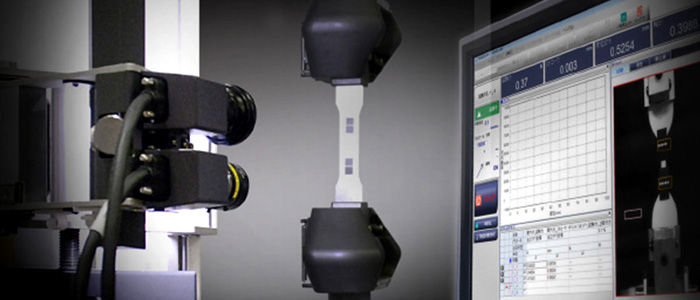Width Measurement Functionality
Single and Dual Camera Models
High-intensity LED Lighting System
Extensomètre vidéo sans contact
TRViewX est un extensomètre sans contact avancé qui offre une grande précision de mesure, est capable de mesurer les changements de largeur et est applicable à une grande variété d'applications d'essais de matériaux. En particulier, grâce à sa conception sans contact, TRViewX est parfait pour mesurer des films, des feuilles et d'autres matériaux minces ou étroits sans affecter l'échantillon pendant le test. En outre, TRViewX peut être utilisé pour mesurer les déplacements lors d'essais sous atmosphère contrôlée dans une chambre thermostatique. TRViewX fournit des mesures de haute précision conformément aux normes ISO 9513 Classe 0.5 et JIS B 7741 Classe 0.5 pour les mesures d'allongement et ISO 9513 Classe 1 et JIS B 7741 Classe 1 pour les mesures de largeur. Il est conforme aux normes d'essai de traction sur plastique, notamment ISO 527, JIS K7161 et ASTM D638, et supporte même les éprouvettes de 75 mm de longueur (éprouvettes de type A1) spécifiées dans les normes ISO 527 et JIS K 7161.

TRViewX Non-Contact Digital Video Extensometer-Example of Plastic Measurements
TRViewX is an advanced non-contact extensometer that offers high-measurement accuracy, is capable of measuring width changes, and is applicable to a wide variety of materials testing applications. In particular, due to the non-contact design, TRViewX is perfect for measuring films, foils, and other thin or narrow materials without affecting the specimen during testing.
TRViewX Non-Contact Digital Video Extensometer -Example of Open Hole CFRP Plate Measurements
TRViewX Non-Contact Digital Video Extensometer -Example of Open Hole CFRP Plate Measurements
ASTM D5379 V-Notched Beam Testing (losipescu) of CFRP
The V-notched beam testing method (Iosipescu method, ASTM D5379) is used widely in the field of composite materials for testing in-plane shear. This test method applies an asymmetrical four-point compression load to a sample with V-notches, which enables the application of only shear stress on the evaluation area.
This method can be used with various CFRP laminate materials, including unidirectional materials, orthogonally laminated materials, and materials with discontinuous fibers.
ASTM D6484 Open-Hole Compression (OHC) Testing of CFRP
CFRPs have excellent characteristics in terms of specific strength and high rigidity, but they also lose a substantial amount of their strength when a cutout is made. In order to assess the use of composite materials for aircraft, tests must be performed with samples that have a circular hole cut through the center. ASTM D6468 is an open-Hole compression (OHC) testing method that uses a sample with a 6-mm (0.25-inch) diameter circular hole cut in its center.
ASTM D6468 has two loading methods: method A and method B. This video shows method B, in which the sample is compressed via compression plates located on the ends of the sample and jig.
ASTM D6641 Combined Loading Compression (CLC) Testing of CFRP
Compressive strength is an extremely important property of composite materials for product design. A common compression test method is the combined loading compression (CLC) method (ASTM D6641).
The CLC method can be performed with a simple jig construction, using a long and narrow sample without tabs. It enables evaluating strength and measuring modulus of elasticity simultaneously.